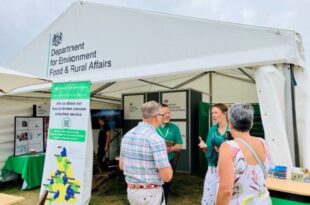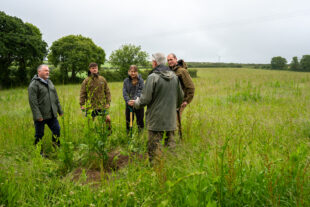https://defrafarming.blog.gov.uk/video-diary-farmer-jess-brooks-on-the-sustainable-farming-incentive-pilot-transcript/
Video Diary: Farmer Jess Brooks on the Sustainable Farming Incentive pilot transcript
Jess Brooks
Welcome to South Thorness Farm on the Isle of Wight. We're on the northern coast of the island, nestled in a heritage coastline in an AONB (Area of Outstanding Natural Beauty) and very close to Newtown National Nature Reserve.
Our family has farmed South Thorness Farm for over a century now. The land has been used for various enterprises, including dairy, beef, pigs, sheep and a number of small animal enterprises. These days, the land is managed mostly as hay meadows and also mixed grazing with equine and small diversifications.
Adrian
About 30 acres of grass will be cut in July, and that will be sold standing to a neighbouring beef farm.
Jess
In terms of biodiversity here on the farm, we're not doing too bad. We've got interesting wildlife like red squirrels, brown hares. Skylarks and swallows breed here, so do barn owls and kestrels, and we have hazel dormice in the hedges.
We have numerous species of butterflies and in our ponds we've got lots of different types of dragonfly and damsel fly, but also a rare foxtail grass.
Joyce
Our hay meadows are very low input, with farmyard manure used sparingly to encourage the hay crop. Sheep graze the aftermath, resulting in the meadows having a good amount of herbs, with 15 to 20 flowers and grass species in any one place.
We have left many hedges to grow into tall wide belts of scrub, which are full of fruit, nectar and shelter for wildlife. We have also planted a new native hedgerow as a red squirrel corridor.
Sarah
At the farm, we have two ponds and a headwater to a small stream, which discharges into a nearby triple SI (Site of Special Scientific Interest).
We try to do our bit for water quality by making sure that the activities on farm have as minimal impact as possible. We do this by ensuring that manure is spread sparingly and we keep an eye on our soil health and nutrient indexes through soil testing.
Jess
So what can we do better on the farm under the Sustainable Farming Incentive? Well, we can increase the area managed for hay and we can increase the floral diversity in the meadows by tweaking the grazing regime, but also perhaps re-seeding key species that are missing, including oxeye daisy, knapweed and yellow rattle.
We'd also like to create more field corners in the meadows by allowing oak trees to regenerate, and this happens quite readily here on the island with the lack of deer, and that will complement the hedge creation and management that we've done already.
We'd also like to leave more of our meadow margins uncut, and that will provide more habitat for over wintering insects and nesting birds. We'd also like to take a look at the capital grants available next year in order to perhaps gap up some hedges and look at manure storage.
We're entering the Sustainable Farming Incentive because we believe that small grassland farms like ours have an important role to play in the future of the countryside, and 55 acres like we have here doesn't seem like very much, but we do have a part to play, and it's not an insignificant amount of land and we can sequester carbon here, we can attract and support more wildlife, and we can lock down nutrients and help clean water.



